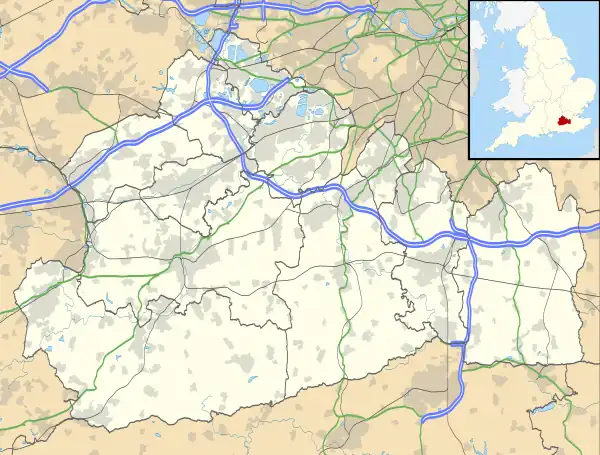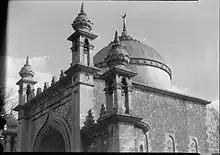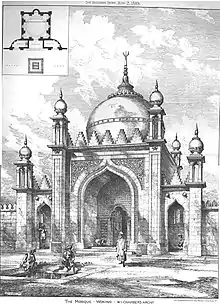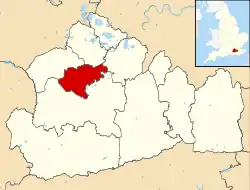Shah Jahan Mosque, Woking
The Shah Jahan Mosque (also known as Woking Mosque) in Oriental Road, Woking, England, is the first purpose-built mosque in the United Kingdom. Built in 1889, it is located 30 miles (50 km) southwest of London. It is a Grade I listed building.[1]
| Shah Jahan Mosque | |
|---|---|
 | |
| Religion | |
| Affiliation | Sunni Islam (previously Lahore Ahmadiyya Movement) |
| Location | |
| Location | Oriental Road, Woking, England |
 Shown within Surrey | |
| Geographic coordinates | 51°19′18.5″N 0°32′51″W |
| Architecture | |
| Architect(s) | W. I. Chambers |
| Type | Mosque |
| Style | Indo-Islamic architecture |
| Completed | 1889 |
| Specifications | |
| Dome(s) | 1 |
| Minaret(s) | 2 miniature |
| Website | |
| shahjahanmosque | |
The Mosque carries out interfaith activities with the aim of promoting understanding, peace and harmony.
Construction


The Shah Jahan Mosque was built in 1889 by Hungarian-British Orientalist Gottlieb Wilhelm Leitner. It was partly funded by Sultan Shah Jahan Begum of Bhopal, as a place for students at the Oriental Institute in Woking to worship. The mosque was designed by architect William Isaac Chambers (1847–1924) and built in Bath and Bargate stone. It was designed in a late Mughal style, and has a dome, minarets, and a courtyard.[2] The architecture was described by Pevsner Architectural Guides as "extraordinarily dignified".[3] The alignment with Mecca was established by a ship's captain, brought in to take bearings.[1]
The Oriental Institute, for the students of which the mosque was constructed, was founded by Leitner in 1881. He had purchased the former Royal Dramatic College building in Woking and established the Institute in order to promote oriental literature. It awarded degrees from the University of the Punjab in Lahore, Pakistan.[2]
History
The mosque became the first formal place of Islamic worship in England. Queen Victoria's British Indian employees and her British Indian secretary, Abdul Karim, used the mosque when the Queen visited Windsor Castle. A small number of dignitaries, students, and guests used the mosque until Leitner's death in 1899, following which the mosque closed.[2]
The mosque fell into disuse between Leitner's death and 1913.[4] The London Mosque fund (which was founded in 1910) created the Woking Mosque Trust on Wednesday 17 April 1912.[5] During that meeting it was agreed by all members that they were to take over the title deeds. It was also unanimously agreed by the committee members that Leitner's son should be elected to the Woking mosque trust committee. The Woking Mosque, the Memorial House and related property was passed into the ownership of the Woking Mosque Trust by a document of Indenture dated 12 April 1915[6]
Khwaja Kamal-ud-Din's son Khwaja Nazir Ahmad gave credit to Mirza Sir Abbas Ali Baig for saving the mosque from being sold by the Leitner family for the purposes of a private factory.
"It is, however, with his services to the cause of Islam that we of the Woking Muslim Mission are chiefly concerned. It was Sir Abbas Ali Baig who saved from the hands of the Leitner family the Shah Jehan Mosque and Sir Salar Jung Memorial House at Woking and thus rescued them from the fate of being converted into a private factory. He subsequently founded the Woking Mosque Trust and raised funds for its maintenance."[7]
Khwaja Kamal-ud-Din, a prominent Kashmiri lawyer was invited to become the Imam and help maintain the mosque.[8]
It attracted royal visitors and famous British converts, such as Lord Headley and Marmaduke Pickthall. During the First World War, the incumbent imam, Sadr-Ud-Din, petitioned the UK government to grant nearby land to the mosque as a burial ground for British Indian Muslim soldiers. By 1917, this burial ground, designed by T Herbert Winney and now Grade II listed,[9] had been constructed and received the bodies of 19 soldiers from the hospital for British Indian soldiers at Brighton Pavilion.[2]
On 28 May 1922, the mosque held a celebration of Eid al-Fitr at the end of Ramadan, thought to have been the first time such public celebration had taken place in the United Kingdom. It was at this celebration that Kamal-ud-Din announced that the mosque would be named Shah Jehan, after its benefactress.[1]
Until the arrival of Pakistani immigrants in the UK in the 1960s, the Shah Jahan Mosque was the centre of Islam in Britain. It was from the mosque that The Islamic Review was published, as well as Maulana Muhammad Ali's popular English translations of the Quran. It has also been claimed as the location at which the name 'Pakistan' was coined.[10] Among those that visited the mosque in this time were Faisal of Saudi Arabia, Muhammad Ali Jinnah, Haile Selassie, Mir Yousuf Ali Khan, Aga Khan III, and Tunku Abdul Rahman.[11]
Sunni period
By the 1960s, the Ahmadi influence of the mosque had declined and it was seen more as a local mosque than vital to the practise of Islam in the UK. In the 1970s, it transferred into Sunni hands and was revived as an important place of worship in the community.[12] The mosque was badly damaged in June 2016 after floods swamped homes in the surrounding area.[13]
In fiction
Chapter IX of HG Wells's The War of the Worlds, published in 1898, contains a description of the Mosque being damaged:[14]
About six in the evening, as I sat at tea with my wife in the summerhouse talking vigorously about the battle that was lowering upon us, I heard a muffled detonation from the common, and immediately after a gust of firing. Close on the heels of that came a violent rattling crash, quite close to us, that shook the ground; and, starting out upon the lawn, I saw the tops of the trees about the Oriental College burst into smoky red flame, and the tower of the little church beside it slide down into ruin. The pinnacle of the mosque had vanished, and the roof line of the college itself looked as if a hundred-ton gun had been at work upon it.
See also
References
- Historic England. "Shah Jehan Mosque, Oriental Road (Grade I) (1264438)". National Heritage List for England. Retrieved 12 March 2018.
- "Shah Jahan Mosque, Woking". Exploring Surrey's Past. Retrieved 17 December 2016.
- "Shah Jahan Mosque". Woking Borough Council. Retrieved 17 December 2016.
- "Khwaja Kamal-ud-Din first visit to the mosque".
- "Creation Woking mosque trust".
- "Indenture document text" (PDF).
- "Sir Abbas Ali Baig". Woking Muslim Mission. Retrieved 3 April 2022.
- "Khwaja Kamal-ud-Din invited to become Imam of the mosque".
- Historic England (6 January 1984). "Muslim Burial Ground (Grade II) (1236560)". National Heritage List for England.
- Glancey, Jonathan (17 June 2002). "The ideal dome show". The Guardian. Retrieved 17 December 2016.
- "The History of the Shah Jahan Mosque in Woking". Islam in British Stone. Retrieved 17 December 2016.
- "History of the Mosque - Part 3". Shah Jahan Mosque. Retrieved 17 December 2016.
- "Woking's Shah Jahan Mosque damaged in flooding". getSurrey. 11 May 2016. Retrieved 17 December 2016.
- "Iain Sinclair on HG Wells's The War of the Worlds". the Guardian. 25 June 2004. Retrieved 27 May 2022.
External links
- Website: Shah Jahan Mosque
- AAIIL: Woking Mosque and the Woking Muslim Mission
- BBC: Forty Eight Hours – Tour: Woking Mosque (Photo of the Mosque in the 1900s)
- British Muslim Heritage – London’s Mosques
- Historic England. "the mosque (1264438)". National Heritage List for England.
- Historic England. "the entrance walls (1236747)". National Heritage List for England.


_(3).JPG.webp)
.JPG.webp)
_(July_2013)_(7).jpg.webp)
_(2).JPG.webp)
